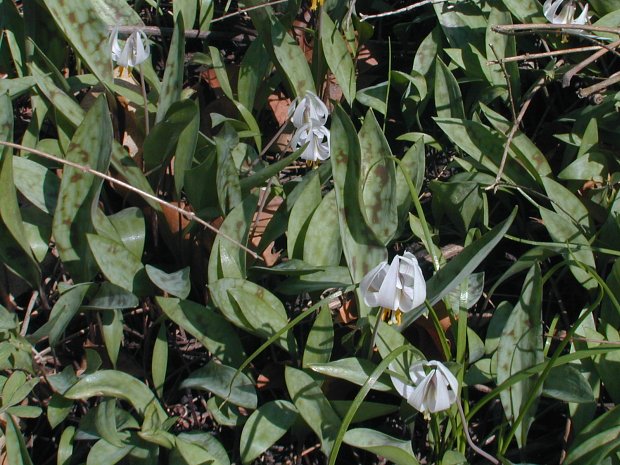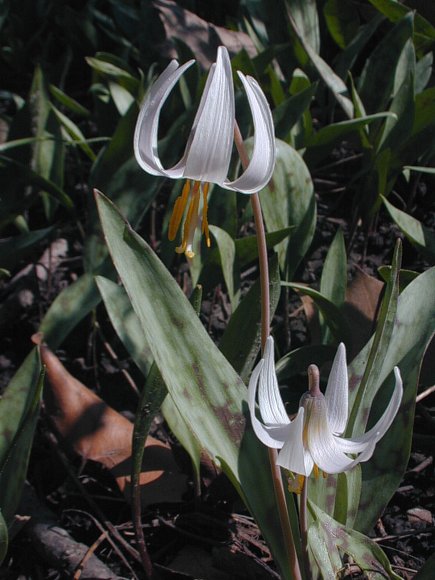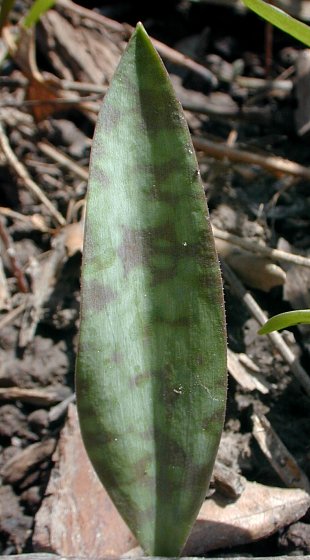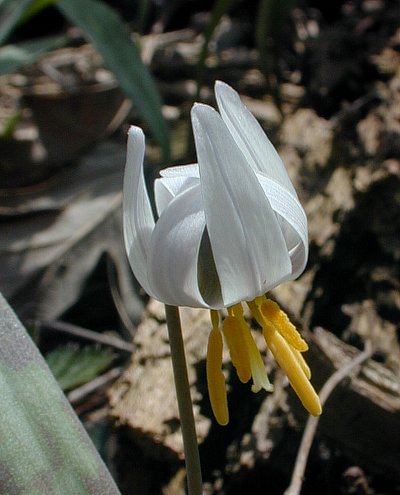Description: This herbaceous perennial plant is about 4-6" tall, consisting of 1-2 basal leaves and a flowering stalk with a single flower. Immature plants produce a single leaf and fail to flower, while mature plants that bloom produce a pair of leaves. The basal leaves are up to 6" long and 2" across. They are elliptic, lanceolate, or narrowly ovate, and smooth (entire) along their margins. The upper leaf surface is mottled pale green and brownish or grayish green, while the lower leaf surface is pale to medium green. Both leaf surfaces are glabrous; the upper leaf surface is often waxy. The leaves often curve upward slightly from the midvein to the margins. A naked flowering stalk develops between the basal leaves of mature plants. This stalk is light green to reddish brown and glabrous; it nods downward at its apex, where the flower occurs.

Each nodding flower is about 1½" long and across; it consists of 6 white tepals, 6 stamens with long yellow anthers, and a slender style with a stigma that has 3 lobes that spread outward. The tepals are linear-lanceolate and strongly recurved, while the stamens and style are exerted. The blooming period occurs during mid-spring and lasts about 2 weeks. Each fertilized flower is replaced by a 3-chambered seed capsule that is ovoid and about ¾" long. Each chamber of the seed capsule contains 2 rows of flattened seeds. The root system consists of a corm that is several inches below the surface of the ground; this corm produces fibrous roots at its base and occasionally sends out underground stolons that can form new plants a few inches away from the mother plant. White Trout Lily can produce large colonies of plants if it is left undisturbed for several decades.

Cultivation:
The preference is dappled sunlight during the spring, moist to mesic
conditions, and a rich loamy soil with decaying leaf mould. Situations
involving more shade are tolerated later in the year. The foliage
withers away during the summer. It takes several years for a new plant
to fully develop and bloom. Corms can be transplanted successfully
during the fall, while the establishment of new plants from seeds is
difficult and slow.
Range & Habitat:
The native White Trout Lily is a common plant that occurs in every
county of
Illinois, except for Jo Davies county in the extreme NW corner of the
state (see Distribution
Map). Habitats include moist to mesic deciduous woodlands and
gentle slopes in wooded areas. An abundance of this plant indicates
that a woodlands has never been subjected to the plow or bulldozed
over. White Trout Lily is one of the spring wildflowers that is
threatened by the spread of Alliaria petiolata
(Garlic Mustard) in wooded areas.

Faunal
Associations:
The flowers are primarily pollinated by both long-tongued and
short-tongued bees, including honeybees, mason bees (Osmia spp.),
cuckoo bees (Nomada spp.),
digger bees (Synhalonia
belfragii), Halictid
bees (Halictus spp.,
Lasioglossum spp.),
plasterer bees (Colletes
inaequalis), and Andrenid bees (Andrena spp.). The
bees suck nectar
from the flowers; honeybees and short-tongued bees also collect pollen.
An oligolectic bee of Erythronium spp. (Trout
Lilies) is Andrena erythronii. Less typical insects
visiting the flowers for nectar include the Giant Bee Fly (Bombylius
major), butterflies, and skippers. Trout Lilies (Erythronium
spp.) are occasionally eaten by White-tailed Deer, but the
damage is
usually minor because of the low stature and ephemeral nature of the
foliage.
Photographic Location:
A deciduous woodlands at Busey Woods in Urbana, Illinois.

Comments: White Trout Lily usually blooms a little earlier than other spring wildflowers in woodlands; this blooming period is short, and immature plants that don't bloom always outnumber mature plants. Both the flowers and foliage are attractive (especially if the latter is mottled). The other Trout Lilies in Illinois are less common; they include Erythronium americanum (Yellow Trout Lily) and Erythronium mesochoreum (Prairie Trout Lily). Yellow Trout Lily has yellow flowers and the lobes of its stigmas are united, rather than spreading. Prairie Trout Lily resembles a White Trout Lily with unmottled foliage. However, it produces a larger seed capsule (about 1" long) that nods downward from its stalk, sometimes touching the ground. White Trout Lily has a smaller seed capsule (about ¾" long) that remains more or less erect on its stalk. The flowers of Prairie Trout Lily are light blue-violet more often than those of White Trout Lily, and its basal leaves tend to be less broad and more strongly folded upward along their midveins.